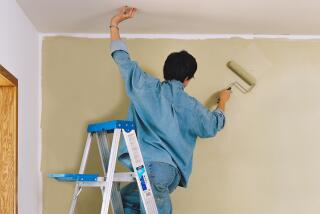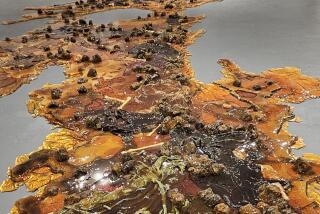Exterior Motives
- Share via
Just about everybody has stucco.
That’s great if you are a conformist or hate to scrape and paint wood siding every few years, but it does tend to make everybody’s house look like everybody else’s.
There’s little, it would seem, that can be done to make stucco anything but the rough, dust-catching, dull-finished product that has come to typify the Southern California house.
But if you take a drive along the coast, or into the hills where people still build custom homes, among the towering half-timbered Tudors and faux French chateaux, you can spot a nice little manse--sometimes modern, more often Mediterranean--with a luminous, rich exterior of smooth, smooth stucco.
“The more you texture stucco, the less desirable the look,” says Laguna Beach architect Gary Whitfield. “A smooth look is a richer look. It sets you apart from the merchant-built housing of the tracts.”
The absence of coarse sand or tiny pebbles in the mix turns the ordinary into the extraordinary. Walls of smooth stucco are inviting, not repulsing; they soak up and give back the light; their colors seem more alive.
Of course, they also cost a ton of money. That smoothness comes with hours of patient, skilled, hand troweling by journeymen plasterers. And patient, skilled plasterers aren’t easy to find these days and don’t work cheap.
There’s one other problem, even if cost isn’t an issue. Stucco--including expensive, smooth stucco--cracks and cracks and cracks, thanks to Southern California’s unstable soil and its propensity for earthquakes.
That’s why several plasterers, including Laguna Plastering’s Gary Simpson, have been aggressively selling architects and remodeling contractors on a stucco replacement system that uses a troweled-on acrylic substance over fiberglass mesh and a lightweight foam insulation board.
“It’s a transition from the old, traditional methods to new technologies and methods,” said Simpson, who added that, applied properly, the acrylic systems are watertight, highly resistant to cracking and virtually maintenance free. With proper cleaning, they may never need to be painted.
*
In Southern California, the two systems most often used are called Dryvit and Sto, said Whitfield, principal of Whitfield Associates.
Developed in Europe after World War II and brought to this country for use in commercial construction, the acrylic systems now are used in both commercial and big-budget custom residential work, Whitefield said.
The Sto system is made by Sto Industries of Atlanta. Dryvit Systems Inc., of West Warwick, R.I., makes the system used by Simpson, who has added his own touch.
He has developed a proprietary color coat that combines special oxides and a unique troweling technique to give the finished product a patina that would take Mother Nature decades to achieve. He calls it a Venetian finish after the warm, softly aged colors that typify the centuries-old stone and smooth-plastered homes of that Italian city.
One example of his work can be seen inside the gates of the Irvine Co.’s posh new Pelican Point development, where huge custom homes are being built on million-dollar lots.
Simpson’s crew has given a Mediterranean-style home there nearly glass-smooth walls with a bronzy patina that glows in the ocean air.
Across the street and up a hillside, another builder has opted for a traditionally troweled-and-pointed smooth stucco finish.
The house Simpson “plastered” looks as if it has been there for decades, with a color that has melted into the finish. The other looks brand new, with appreciably rougher stucco and a multi-tone paint job that just approximates a weathered and aged look.
In addition to special coloring, which wouldn’t work with stucco, Simpson says he likes the acrylic system for its ease of application and its lightweight, insulating abilities and flexibility.
That flexibility is double-edged: The acrylic material is physically flexible, able to resist cracks by stretching, and the system is flexible, allowing all sorts of modifications and special treatments to be added while a job is in progress without having to tear out all the finishing work that already has been done.
The reason is that the plastic-based acrylic puts the weather barrier--or waterproofing--on the outside.
A traditional stucco or cement-based plaster absorbs water and lets it through. A stucco house is first covered in waterproof paper to prevent moisture from coming through the walls. Then a wire lath--much like chicken-wire fencing--is stretched over the paper, and two undercoats of stucco are applied before the final coat. The final coat, which usually contains the color as well, is sprayed or troweled on.
When anything is added to a stucco-finished building, the existing stucco must be cut back; new waterproof paper must be applied over the paper on the original part of the wall, and new wire lath must be woven into the old lath to help tie it all together. And even then it is almost a certainty that a crack will develop where the new stucco meets the old.
With a system such as Dryvit, the acrylic finish coat is waterproof.
A complete system, applied over bare framing, forms a four-layer sandwich of fire-retarding backing material, insulation board, a base coat into which a fiber glass mesh is pressed, and then the waterproof acrylic finish coat, which also contains the color.
To add an ornamental “eyebrow” over a window or to attach raised edging to a doorway that already has been finished, Simpson cuts the shape from foam board, glues and nails it into place, trowels on the acrylic in a finish that matches what’s already there and seals the joint between the old work and the new with a clear caulk.
*
Whitfield, who has used both acrylic systems, says they eliminate most of the cracking that would mar a smooth stucco finish and enable architects to add a lot of detail work that would just not look good in stucco.
For one project, his crew created “a lot of ribbed effect and stepping and carving of the finish that would have been real hit-and-miss if we’d tried to do it in stucco . . . This is real contemporary; you can shape it like Styrofoam and get really smooth inside and outside curves that you just can’t get with stucco.”
Dryvit’s catalog shows the system using layers of foam backing to imitate stonework by building up large areas and leaving deeply chiseled grooves between the sections so that the house appears to have been built of huge bocks of granite.
The acrylic systems also are great for new custom construction because they aren’t as messy to apply as stucco, cutting down on cleanup costs, says Simpson.
They also go up a lot faster--no lengthy drying periods between coats--so the entire job gets done quicker.
The same features can make an acrylic system work on a remodeling job, although homeowners need to remember that the product must be applied by hand. Compared with garden-variety stucco, acrylic walls are expensive; the savings come in over the long term, not up front.
Simpson, who has applied more than 400,000 square feet of acrylic wall system since he started working with it in 1988, figures that a job involving application of the entire system on a custom-built home would cost about $6 a square foot--versus $5 per square foot for a hand-troweled, smooth stucco finish that would have to be painted at an additional cost after it cured.
For jobs involving re-covering existing homes, prices would range from about $2 a square foot for acrylic only to $4 per square foot for acrylic backed by fiberglass mesh to reduce cracking.
Standard re-stucco work on a sound surface without a lot of elaborate scaffolding would run about $1.25 a foot.
The systems also are not very well known. They must be applied by certified specialists, usually journeyman plasterers, so they aren’t available at do-it-yourself warehouse stores.
In the end, it boils down to matters of aesthetics and of budget.
Because of the cost, though, Whitfield doesn’t see a big future for acrylic finishes in the tract home remodeling market.
“It wouldn’t really change [the look], I’m afraid. Once a tract house, always a tract house, unless you do some major remodeling.”


